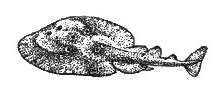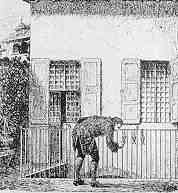

 The new paradigm in neurophysiology started by a series of
simple observations by naturalists regarding "animal
electricity". It was known,
for instance that certain animals, such as the eel and the torpedo (electric ray) were capable of giving shocks
when touched, which were very similar to the effects of other electrical shocks (given by a charged Leyden jar, for instance). Thus, it was apparent that animals could
generate electricity in their bodies.
The new paradigm in neurophysiology started by a series of
simple observations by naturalists regarding "animal
electricity". It was known,
for instance that certain animals, such as the eel and the torpedo (electric ray) were capable of giving shocks
when touched, which were very similar to the effects of other electrical shocks (given by a charged Leyden jar, for instance). Thus, it was apparent that animals could
generate electricity in their bodies.
The Italian anatomist and physician Luigi Galvani (1737-1798) was one of the first to investigate experimentally the phenomenon of what came to be named "bioelectrogenesis". In a series of experiments started around 1780, Galvani, working in the University of Bologna, found that the electric current delivered by a Leyden jar or a rotating static electricity generator would cause the contraction of the muscles in the leg of a frog and many other animals, either by applying the charge to the muscle or to the nerve.




Luigi Galvani and his frogs experiments
Trying to prove that lightning was an electrical spark, as Benjamin Franklin had proposed, Galvani suspended the frog's legs with brass hooks from an electrical railing during a thunderstorm. He noted that the muscles would contract not only when lightnings appeared, but also when they were absent. Muscle contraction appeared when the muscle preparation was put into contact with two different metals, indoors or outdoors. In this case, no external electricity was being applied to the muscles, so Galvani was led to the conclusion that the frog's muscles were generating electricity by themselves. In other words, to him it was clear that certain organic tissues were capable of "animal electricity", a term coined by him, a kind of vital energy which he thought was similar, but different from the "natural" electricity generated by machines or in lightnings. He compared the muscle to a small Leyden jar, charged with electricity. When an external charge was applied to the muscles, opposite electrical charges on the inside and outside surfaces would cause an attraction and the ensuing muscle contraction. His conclusions were published on 1791, with an essay titled "De Viribus Electricitatis in Motu Musculari Commentarius" (Commentary on the Effect of Electricity on Muscular Motion).
 The noted Italian physicist Alessandro Volta (1745-1827) repeated Galvani's experiments
at the University of Pavia, and obtained the same results. However, he was not convinced of Galvani's explanation.
He noted that since applying the bimetallic probes to the nerves leading to the muscles, only, would also cause
a contraction, the "Leyden jar" model proposed by Galvani could not be true, and a long controversy started.
Volta proposed the alternative hypothesis (which is the correct one for Galvani's early experiments), that external
electricity was generated by the contact between two kinds of metal. He claimed that the frog muscle worked only
as a detector of the small differences in external electrical potential external; a kind of foil electroscope, so to say.
The noted Italian physicist Alessandro Volta (1745-1827) repeated Galvani's experiments
at the University of Pavia, and obtained the same results. However, he was not convinced of Galvani's explanation.
He noted that since applying the bimetallic probes to the nerves leading to the muscles, only, would also cause
a contraction, the "Leyden jar" model proposed by Galvani could not be true, and a long controversy started.
Volta proposed the alternative hypothesis (which is the correct one for Galvani's early experiments), that external
electricity was generated by the contact between two kinds of metal. He claimed that the frog muscle worked only
as a detector of the small differences in external electrical potential external; a kind of foil electroscope, so to say.
Trying to prove this, he built in 1800 the first electrical pile, or battery: a series of metal disks of two kinds, separated by cardboard disks soaked with acid or salt solutions. This is the basis of all modern wet-cell batteries, and it was a tremendously important scientific discovery, because it was the first method found for the generation of a sustained electrical current. However, regarding Galvani's biological experiments, Volta effectively rejected the idea of an "animal electric fluid".
Later on, Galvani and his cousin, Giovanni Aldini (1762-1834), weres able to demonstrate that animal tissue was indeed a source of electricity, even without metal contact, and that it was present when only one metal was used (a pool of mercury). He also caused a muscle to contract by touching the exposed muscle of one frog with the nerve of another. In this way, he was the first to establish with certainty the existence of bioelectricity. However, he published this in 1794 only, in the supplement of an anonymous book titled "Dell'uso e Dell'attività Dell'arco Conduttore Nella Contrazione dei Muscoli" ("On the Use and Activity of the Conductive Arch in the Contraction of Muscles"). In all these experiments, Volta always tried to refute that they were demonstrations of the existence of animal electricity, by using his theories of external generation of electricity. The definitive experimental clarification of the issue was left to the noted German naturalist Alexander von Humboldt (), in 1797, who was able to uncover two separate and genuine phenomena: bimetal electricity and animal electrogenesis and to point out where Galvani and Volta were right and were they were wrong.
The Galvani vs. Volta debate was one of the most interesting episodes in the history of science, and was devoid of personal animosity, because Galvani and Volta were both gentleman and friends, and also had high scientific principles (this could not be said about their supporters, who rallied and clashed many times in public and in the academies). In fact, Volta, who generously coined the term galvanism, wrote that Galvani's work "contain[ed] one of the most beautiful and most surprising discoveries." On the other hand, Volta's name originated the terms "voltaic ", "volt", etc. Upon demonstrating the workings of the voltaic pile to the French Academy of Science, he was made into a count of Lombardy by Napoleon Bonaparte, who had dominated that part of Italy.
Galvani's remarkable experiments helped to establish the basis for the biological study of neurophysiology and neurology. The paradigm shift was complete: nerves were not water pipes or channels, as Descartes and his contemporaries thought, but electrical conductors. Information within the nervous system was carried by electricity generated directly by the organic tissue.
The ground was broken for beginning the study of nerve conduction.
A New Model for the Mind![]()
 Nerve
Conduction
Nerve
Conduction
The Discovery of Bioelectricity
Renato M.E. Sabbatini
Brain & Mind Magazine 2(6), June/September
1998
Copyright (c) 1998 The State University of Campinas,
Brazil
Center for Biomedical Informatics